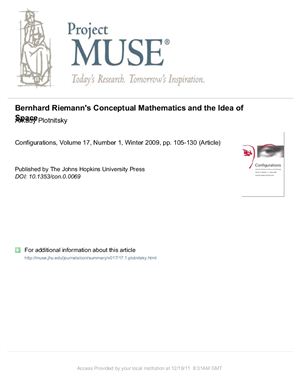Configurations.
Volume 17, Numbers 1-2, Winter 2009.
pp. 105-130.
Subject Headings:
Riemann, Behard, 1826-1866.
Mathematics.
Abstract:
This essay explores the power and fertility of mathematical imagination, as they are manifest in the thought of a nineteenth-century German mathematician Behard Riemann (1826–1866), one of the greatest and most imaginative mathematicians who ever lived. Riemann introduced radically new ideas in every main field of mode mathematics: algebra, analysis, geometry, and topology. These ideas transformed each of these fields and played major roles in making mathematics into what it is now. The essay considers in particular two interrelated aspects of Riemann's work: the first is his concept of "manifold(ness)," which transformed our mathematical, physical, and philosophical understanding of spatiality; and the second is the conceptual character of Riemann's mathematical thinking as responsible for the radical nature of his ideas, such as those conceing spatiality and/as manifoldness. The essay also addresses, in closing, some of the implications of Riemann's ideas for mode physics, most especially for Albert Einstein's general relativity—his non-Newtonian theory of gravitation.
Volume 17, Numbers 1-2, Winter 2009.
pp. 105-130.
Subject Headings:
Riemann, Behard, 1826-1866.
Mathematics.
Abstract:
This essay explores the power and fertility of mathematical imagination, as they are manifest in the thought of a nineteenth-century German mathematician Behard Riemann (1826–1866), one of the greatest and most imaginative mathematicians who ever lived. Riemann introduced radically new ideas in every main field of mode mathematics: algebra, analysis, geometry, and topology. These ideas transformed each of these fields and played major roles in making mathematics into what it is now. The essay considers in particular two interrelated aspects of Riemann's work: the first is his concept of "manifold(ness)," which transformed our mathematical, physical, and philosophical understanding of spatiality; and the second is the conceptual character of Riemann's mathematical thinking as responsible for the radical nature of his ideas, such as those conceing spatiality and/as manifoldness. The essay also addresses, in closing, some of the implications of Riemann's ideas for mode physics, most especially for Albert Einstein's general relativity—his non-Newtonian theory of gravitation.

